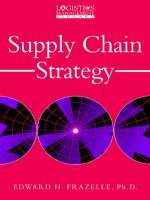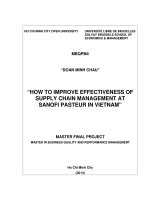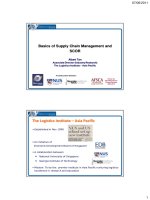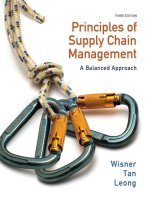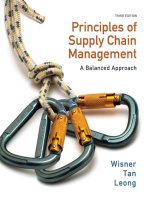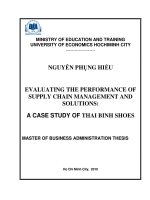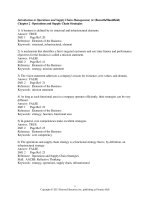Principles of supply chain management 3rd wisner tan leong
Bạn đang xem bản rút gọn của tài liệu. Xem và tải ngay bản đầy đủ của tài liệu tại đây (4.08 MB, 594 trang )
LibraryPirate
This is an electronic version of the print textbook. Due to electronic rights restrictions,
some third party content may be suppressed. Editorial review has deemed that any suppressed
content does not materially affect the overall learning experience. The publisher reserves the right
to remove content from this title at any time if subsequent rights restrictions require it. For
valuable information on pricing, previous editions, changes to current editions, and alternate
formats, please visit www.cengage.com/highered to search by ISBN#, author, title, or keyword for
materials in your areas of interest.
Principles of
Supply Chain
Management
A BALANCED APPROACH
3e
JOEL D. WISNER
University of Nevada, Las Vegas
•
KEAH-CHOON TAN
University of Nevada, Las Vegas
•
G. KEONG LEONG
University of Nevada, Las Vegas
Australia • Brazil • Japan • Korea • Mexico • Singapore • Spain • United Kingdom • United States
Principles of Supply Chain Management,
Third edition
Joel D. Wisner, Keah-Choon Tan,
G. Keong Leong
Editorial Director: Jack W. Calhoun
Sr. Acquisitions Editor: Charles
McCormick, Jr.
© 2012, 2009 South-Western, a part of Cengage Learning
ALL RIGHTS RESERVED. No part of this work covered by the copyright
herein may be reproduced, transmitted, stored or used in any form or by
any means graphic, electronic, or mechanical, including but not limited
to photocopying, recording, scanning, digitizing, taping, Web distribution,
information networks, or information storage and retrieval systems,
except as permitted under Section 107 or 108 of the 1976 United States
Copyright Act, without the prior written permission of the publisher.
Developmental Editor: Daniel Noguera
Editorial Assistant: Nora Heink
Marketing Manager: Adam Marsh
Media Editor: Chris Valentine
Manufacturing Buyer: Miranda Klapper
Production Service: PreMediaGlobal
For product information and technology assistance, contact us at
Cengage Learning Customer & Sales Support, 1-800-354-9706
For permission to use material from this text or product,
submit all requests online at cengage.com/permissions
Further permissions questions can be emailed to
Sr. Art Director: Stacy Jenkins Shirley
Cover Designer: Lou Ann Thesing
Cover Image: iStock Photo
Library of Congress Control Number: 2010943343
ISBN 13: 978-0-538-47546-4
ISBN 10: 0-538-47546-3
South-Western
5191 Natorp Boulevard
Mason, OH 45040
USA
Cengage Learning products are represented in Canada by
Nelson Education, Ltd.
For your course and learning solutions, visit www.cengage.com
Purchase any of our products at your local college store or at our
preferred online store www.cengagebrain.com
Printed in the United States of America
1 2 3 4 5 6 7 15 14 13 12 11
To CJ, Hayley and Blake.
JOEL D. WISNER
To Shaw Yun, Wen Hui and Wen Jay.
KEAH-CHOON TAN
To Lin and Michelle.
G. KEONG LEONG
Brief Contents
Preface xv
Acknowledgements xvii
About the Authors xviii
Part 1
Supply Chain Management: An Overview 1
Chapter
Part 2
2
3
4
5
6
7
8
Demand Forecasting 133
Resource Planning Systems 165
Inventory Management 207
Process Management—Lean and Six Sigma
in the Supply Chain 249
Distribution Issues in Supply Chain Management 297
Chapter 9
Chapter 10
Chapter 11
Chapter 12
Part 5
Purchasing Management 37
Creating and Managing Supplier Relationships 73
Ethical and Sustainable Sourcing 99
Operations Issues in Supply Chain Management 131
Chapter
Chapter
Chapter
Chapter
Part 4
Introduction to Supply Chain Management 3
Supply Issues in Supply Chain Management 35
Chapter
Chapter
Chapter
Part 3
1
Domestic U.S. and Global Logistics 299
Customer Relationship Management 343
Global Location Decisions 375
Service Response Logistics 401
Integration Issues in Supply Chain Management 445
Chapter 13
Chapter 14
Supply Chain Process Integration 447
Performance Measurement Along the Supply Chain 481
On the Companion Website
Cases in Supply Chain Management
Student and Instructor Materials
iv
Contents
Preface xv
Acknowledgements xvii
About the Authors xviii
Part 1
Supply Chain Management: An Overview 1
Chapter
Part 2
1
Introduction to Supply Chain Management 3
Introduction 5
Supply Chain Management Defined 6
The Importance of Supply Chain Management 9
The Origins of Supply Chain Management in the U.S. 12
The Foundations of Supply Chain Management 15
Supply Elements 15
Operations Elements 17
Logistics Elements 19
Integration Elements 21
Current Trends in Supply Chain Management 22
Expanding (and Contracting) the Supply Chain 23
Increasing Supply Chain Responsiveness 24
The Greening of Supply Chains 25
Reducing Supply Chain Costs 26
Summary 28
Key Terms 28
Discussion Questions 28
Internet Questions 29
Appendix 1.1: The Beer Game 30
Beer Game Questions and Exercises 34
Supply Issues in Supply Chain Management 35
Chapter
2
Purchasing Management 37
Introduction 39
A Brief History of Purchasing Terms 39
The Role of Supply Management in an Organization 40
The Financial Significance of Supply Management 42
The Purchasing Process 43
The Manual Purchasing System 43
Electronic Procurement Systems (e-Procurement) 47
Small Value Purchase Orders 49
Sourcing Decisions: The Make-or-Buy Decision 53
Reasons for Buying or Outsourcing 54
v
vi
Contents
Chapter
3
Reasons for Making 54
Make-or-Buy Break-Even Analysis 55
Roles of Supply Base 57
Supplier Selection 57
How Many Suppliers to Use 60
Reasons Favoring a Single Supplier 60
Reasons Favoring Multiple Suppliers 61
Purchasing Organization 61
Advantages of Centralization 62
Advantages of Decentralization 62
International Purchasing/Global Sourcing 63
Reasons for Global Sourcing 64
Potential Challenges for Global Sourcing 64
Countertrade 65
Procurement for Government/Nonprofit Agencies 65
Characteristics of Public Procurement 66
Summary 68
Key Terms 68
Discussion Questions 69
Internet Questions 70
Spreadsheet Problems 70
Creating and Managing Supplier Relationships 73
Introduction 75
Developing Supplier Relationships 75
Building Trust 76
Shared Vision and Objectives 76
Personal Relationships 76
Mutual Benefits and Needs 76
Commitment and Top Management Support 77
Change Management 77
Information Sharing and Lines of Communication 77
Capabilities 78
Performance Metrics 78
Continuous Improvement 81
Key Points 81
Supplier Evaluation and Certification 82
The Weighted Criteria Evaluation System 84
ISO 9000 87
ISO 14000 88
Supplier Development 89
Supplier Recognition Programs 91
Supplier Relationship Management 92
Summary 97
Key Terms 97
Discussion Questions 97
Contents
vii
Chapter
Part 3
4
Ethical and Sustainable Sourcing 99
Introduction 100
Ethical and Sustainable Sourcing Defined 102
Ethical Sourcing 102
Sustainable Sourcing 105
Developing Ethical and Sustainable Sourcing Strategies 109
Supply Base Rationalization Programs 111
Ethical and Sustainable Supplier Certification Programs 112
Outsourcing Products and Services 113
Insourcing 114
Co-sourcing 114
Early Supplier Involvement 115
Vendor Managed Inventories 116
Supplier Co-location 117
Strategic Alliance Development 117
Negotiating Win-Win Strategic Alliance Agreements 119
Use of E-Procurement Systems 121
Rewarding Supplier Performance 123
Benchmarking Successful Sourcing Practices 124
Using Third-Party Supply Chain Management Services 125
Assessing and Improving the Firm’s Own Sourcing Function 126
Summary 128
Key Terms 128
Discussion Questions 128
Internet Questions 130
Operations Issues in Supply Chain Management 131
Chapter
5
Demand Forecasting 133
Introduction 135
Demand Forecasting 136
Forecasting Techniques 137
Qualitative Methods 137
Quantitative Methods 138
Forecast Accuracy 147
Useful Forecasting Websites 150
Collaborative Planning, Forecasting and Replenishment 150
Software Solutions 156
Forecasting Software 156
CPFR Software 161
Summary 162
Key Terms 162
Discussion Questions 162
Spreadsheet Problems 163
viii
Contents
Chapter
6
Chapter
7
Resource Planning Systems 165
Introduction 166
Operations Planning 167
The Aggregate Production Plan 168
The Chase Production Strategy 169
The Level Production Strategy 171
Master Production Scheduling 173
Master Production Schedule Time Fence 174
Available-to-Promise Quantities 175
The Bill of Materials 178
Material Requirements Planning 181
Terms used in Material Requirements Planning 182
Capacity Planning 185
Capacity Strategy 186
Distribution Requirements Planning 187
The Legacy Material Requirements Planning Systems 187
Manufacturing Resource Planning 189
The Development of Enterprise Resource Planning Systems 190
The Rapid Growth of Enterprise Resource
Planning Systems 192
Implementing Enterprise Resource Planning Systems 193
Advantages and Disadvantages of Enterprise Resource
Planning Systems 195
Enterprise Resource Planning System Advantages 195
Enterprise Resource Planning System Disadvantages 197
Enterprise Resource Planning Software Applications 197
Enterprise Resource Planning Software Providers 199
Summary 201
Key Terms 201
Discussion Questions 202
Internet Questions 203
Spreadsheet Problems 203
Inventory Management 207
Introduction 208
Dependent Demand and Independent Demand 210
Concepts and Tools of Inventory Management 210
The Functions and Basic Types of Inventory 211
Inventory Costs 211
Inventory Investment 212
The ABC Inventory Control System 213
Radio Frequency Identification 217
Inventory Models 222
The Economic Order Quantity Model 222
The Quantity Discount Model 227
Contents
ix
Chapter
8
The Economic Manufacturing Quantity Model 228
The Statistical Reorder Point 234
The Continuous Review and the Periodic Review
Inventory Systems 239
Summary 242
Key Terms 242
Discussion Questions 242
Internet Questions 243
Problems 243
Spreadsheet Problems 245
Process Management—Lean and Six Sigma
in the Supply Chain 249
Introduction 250
Lean Production and the Toyota Production System 251
Lean Thinking and Supply Chain Management 255
The Elements of Lean 257
Waste Reduction 257
Lean Supply Chain Relationships 260
Lean Layouts 261
Inventory and Setup Time Reduction 262
Small Batch Scheduling 263
Continuous Improvement 266
Workforce Commitment 266
Lean Systems and the Environment 267
The Origins of Six Sigma Quality 268
Comparing Six Sigma and Lean 270
Lean Six 271
Six Sigma and Supply Chain Management 271
The Elements of Six Sigma 273
Deming’s Contributions 274
Crosby’s Contributions 274
Juran’s Contributions 274
The Malcolm Baldrige National Quality Award 276
The ISO 9000 and 14000 Families of Management
Standards 279
The DMAIC Improvement Cycle 280
Six Sigma Training Levels 281
The Statistical Tools of Six Sigma 281
Flow Diagrams 281
Check Sheets 282
Pareto Charts 282
Cause-and-Effect Diagrams 284
Statistical Process Control 285
Summary 293
Key Terms 293
x
Contents
Discussion Questions 293
Internet Questions 295
Problems 295
Part 4
Distribution Issues in Supply Chain Management 297
Chapter
9
Chapter 10
Domestic U.S. and Global Logistics 299
Introduction 301
The Fundamentals of Transportation 302
The Objective of Transportation 302
Legal Forms of Transportation 303
The Modes of Transportation 304
Intermodal Transportation 309
Transportation Pricing 310
Transportation Security 312
Transportation Regulation and Deregulation in the U.S. 314
Warehousing and Distribution 318
The Importance and Types of Warehouses 319
Risk Pooling and Warehouse Location 321
Lean Warehousing 324
The Impacts of Logistics on Supply Chain Management 325
Third-Party Logistics (3PL) Services 325
Other Transportation Intermediaries 328
Environmental Sustainability in Logistics 329
Logistics Management Software Applications 331
Transportation Management Systems 331
Warehouse Management Systems 332
Global Trade Management Systems 332
Global Logistics 333
Global Freight Security 333
Global Logistics Intermediaries 334
Foreign-Trade Zones 335
The North American Free Trade Agreement 335
Reverse Logistics 336
The Impact of Reverse Logistics on the Supply Chain 337
Reverse Logistics and the Environment 338
Summary 339
Key Terms 339
Discussion Questions 340
Internet Questions 341
Customer Relationship Management 343
Introduction 345
Customer Relationship Management Defined 346
CRM’s Role in Supply Chain Management 348
Key Tools and Components of CRM 349
Contents
xi
Chapter 11
Segmenting Customers 349
Predicting Customer Behaviors 351
Customer Value Determination 352
Personalizing Customer Communications 352
Automated Sales Force Tools 354
Managing Customer Service Capabilities 355
Designing and Implementing a Successful CRM Program 361
Creating the CRM Plan 362
Involving CRM Users from the Outset 362
Selecting the Right Application and Provider 363
Integrating Existing CRM Applications 364
Establishing Performance Measures 364
Training for CRM Users 365
Recent Trends in CRM 366
Customer Data Privacy 366
Social Media 367
Cloud Computing 369
Summary 371
Key Terms 371
Discussion Questions 371
Internet Questions 373
Global Location Decisions 375
Introduction 376
Global Location Strategies 377
Critical Location Factors 380
Regional Trade Agreements and the World
Trade Organization 380
Competitiveness of Nations 382
The World Economic Forum’s 12 Pillars
of Competitiveness 384
Government Taxes and Incentives 384
Currency Stability 386
Environmental Issues 386
Access and Proximity to Markets 387
Labor Issues 388
Access to Suppliers 388
Utility Availability and Cost 388
Quality-of-Life Issues 389
Right-to-Work Laws 390
Land Availability and Cost 390
Facility Location Techniques 391
The Weighted-Factor Rating Model 391
The Break-Even Model 391
Helpful On-Line Information for Location Analysis 392
Business Clusters 394
xii
Contents
Chapter 12
Part 5
Sustainable Development 396
Summary 398
Key Terms 398
Discussion Questions 398
Internet Questions 399
Spreadsheet Problems 399
Service Response Logistics 401
Introduction 403
An Overview of Service Operations 404
Service Productivity 405
Global Service Issues 406
Service Strategy Development 406
The Service Delivery System 408
Service Location and Layout Strategies 409
Supply Chain Management in Services 411
Service Quality and Customers 415
The Primary Concerns of Service Response Logistics 416
Managing Service Capacity 417
Managing Queue Times 423
Managing Distribution Channels 432
Managing Service Quality 436
Summary 439
Key Terms 439
Discussion Questions and Exercises 440
Problems 441
Internet Questions 443
Integration Issues in Supply Chain Management 445
Chapter 13
Supply Chain Process Integration 447
Introduction 449
The Supply Chain Management Integration Model 450
Identify Critical Supply Chain Trading Partners 450
Review and Establish Supply Chain Strategies 451
Align Supply Chain Strategies with Key Supply Chain
Process Objectives 452
Develop Internal Performance Measures for Key
Process Effectiveness 456
Assess and Improve Internal Integration of Key
Supply Chain Processes 456
Develop Supply Chain Performance Measures for
the Key Processes 459
Assess and Improve External Process Integration
and Supply Chain Performance 459
Extend Process Integration to Second-Tier Supply
Chain Partners 460
Contents
xiii
Chapter 14
Re-evaluate the Integration Model Annually 461
Obstacles To Process Integration Along The Supply Chain 461
The Silo Mentality 462
Lack of Supply Chain Visibility 463
Lack of Trust 465
Lack of Knowledge 467
Activities Causing the Bullwhip Effect 467
Managing Supply Chain Risk And Security 470
Managing Supply Chain Risk 470
Managing Supply Chain Security 474
Summary 478
Key Terms 478
Discussion Questions 478
Internet Questions 479
Performance Measurement Along the Supply Chain 481
Introduction 483
Viewing the Supply Chain as a Competitive Force 484
Understanding End Customers 484
Understanding Supply Chain Partner Requirements 485
Adjusting Supply Chain Member Capabilities 485
Traditional Performance Measures 486
Use of Organization Costs, Revenue and
Profitability Measures 486
Use of Performance Standards and Variances 487
Use of Firm-Wide Productivity and Utilization Measures 488
World-Class Performance Measurement Systems 490
Developing World-Class Performance Measures 490
Supply Chain Performance Measurement Systems 491
Supply Chain Environmental Performance 494
Specific Supply Chain Performance Measures 495
The Balanced Scorecard 496
Web-Based Scorecards 498
The SCOR Model 499
Summary 504
Key Terms 504
Discussion Questions 504
Internet Questions 506
Appendix 1
Areas under the Normal Curve 507
Appendix 2
Answers to Selected End-of-Chapter Problems 508
xiv
Contents
Glossary 511
References 524
Endnotes 528
Author Index 556
Subject Index 557
On the Companion Website
Cases in Supply Chain Management
Part
Part
Part
Part
2
3
4
5
Cases
Cases
Cases
Cases
Student and Instructor Materials
Preface
Welcome to the third edition of Principles of Supply Chain Management: A Balanced
Approach. The practice of supply chain management is becoming widespread in all
industries around the globe today, and both small and large firms are realizing the benefits provided by effective supply chain management. We think this text is unique in that
it uses a novel and logical approach to present discussions of this topic from four perspectives: purchasing, operations, logistics and the integration of processes within these
three vitally important areas of the firm and between supply chain trading partners. We
think this book is somewhat different than the other supply chain management texts
available, since we present a more balanced view of the topic—many of the texts available today concentrate primarily on just one of the three areas of purchasing, operations
or logistics.
The objective of the book is to make readers think about how supply chain management impacts all of the areas and processes of the firm and its supply chain partners, and
to show how managers can improve their firm’s competitive position by employing the
practices we describe throughout the text. Junior- or senior-level business students,
beginning MBA students, as well as practicing managers can benefit from reading and
using this text.
There are a number of additions to this third edition that we hope you will find interesting and useful. There is a greater emphasis on environmental sustainability throughout the text. In addition, each chapter contains new Supply Chain Management in
Action, e-Business Connection, and Global Perspective features, along with new references throughout and new or additional end-of-chapter discussion questions and exercises. Other specific additions and changes to the text are described below.
The textbook also comes with a dedicated website containing dozens of teaching cases
split among each section of the book. Most of the case companies and situations are real,
while others are fictional, and the cases vary from easy to difficult and short to long.
Also on the website is a guide to supply chain management videos along with the
YouTube Website addresses for each video. Finally, Power Point lecture slides are available for downloading. Part of the website is protected and for instructors only, and this
site contains sample syllabi, case teaching notes, answers to all of the end-of-chapter
questions and problems, and a test bank. In the Chapter 1 Appendix, there is a discussion of the Beer Game, with inventory tracking sheets to allow instructors to actually
play the game with their students. Finally, there are quantitative as well as qualitative
problems and questions, Internet exercises and Excel problems spread throughout most
of the chapters.
Part 1 is the overview and introduction of the topic of supply chain management.
This chapter introduces the basic understanding and concepts of supply chain management, and should help students realize the importance of this topic. Core concepts such
as the bullwhip effect, supplier relationship management, forecasting and demand management, enterprise resource planning, transportation management and customer relationship management are discussed. There is also a new section on current trends in
supply chain management.
Part 2 presents supply issues in supply chain management. This very important topic
is covered in three chapters, building from an introduction to purchasing management,
xv
xvi
Preface
to managing supplier relationships and then to ethical and sustainable sourcing. Within
these chapters can be found sections on government purchasing, global sourcing,
e-procurement, software applications, supplier development and green purchasing.
Part 3 includes four chapters regarding operations issues in supply chain management. This section progresses from topics on forecasting, resource planning and inventory management to lean production and Six Sigma. New sections in Part 3 include a
greater emphasis on collaborative planning, forecasting, and replenishment (CPFR);
discussions of distribution requirements planning (DRP) and radio frequency identification (RFID); and finally discussions of the latest lean production and Six Sigma
programs.
Part 4 presents distribution issues in supply chain management and consists of four
chapters. Chapter 9 is a review of domestic U.S. and international logistics and contains
new sections on green transportation, international logistics security and reverse logistics.
This is followed by chapters on customer relationship management, global location decisions and service response logistics. New content in these chapters includes new software
application discussions, trends in customer relationship management, new location
trends in the global economy and cloud computing services.
The final section is Part 5, which presents discussions of the integration issues in supply chain management and performance measurements along the supply chain. While
cooperation and integration are frequently referred to in the text, this section brings the
entire text into focus, tying all of the parts together, first by discussing integration in
detail, followed by a discussion of traditional and world-class performance measurement
systems. New material here includes the topics of supply chain risk management and
expanded coverage of performance measurement models.
We think we have compiled a very interesting set of supply chain management topics
that will keep readers engaged and we hope you enjoy it. We welcome your comments
and suggestions for improvement. Please direct all comments and questions to:
Joel D. Wisner: (primary contact),
Keah-Choon Tan: , or
G. Keong Leong:
Acknowledgements
We greatly appreciate the efforts of a number of fine and hard-working people at
Cengage Learning/South-Western College Publishing. Without their feedback and guidance, this text would not have been completed. The team members are Charles E.
McCormick, Jr., Senior Acquisitions Editor; Adam Marsh, Marketing Manager; and
Daniel Noguera, our Associate Developmental Editor and day-to-day contact person.
A number of other people at Cengage Learning and South-Western also need to be
thanked including Stacy Shirley, Chris Valentine and Libby Shipp. We also would like
to thank Katy Gabel and her people at PreMediaGlobal who put the manuscript into
final copy form.
Additionally, we would like to thank all of the case writers who contributed their
cases to this textbook. Their names, along with their contact information, are printed
with each of the cases on the website. As with any project of this size and time span,
there are certain to be a number of people who gave their time and effort to this textbook, and yet their names were inadvertently left out of these acknowledgments. We
apologize for this and wish to thank you here.
xvii
About the Authors
Joel D. Wisner is Professor of Supply Chain Management at the University of
Nevada, Las Vegas. He earned his BS in Mechanical Engineering from New Mexico
State University in 1976 and his MBA from West Texas State University in 1986.
During that time, Dr. Wisner worked as an engineer for Union Carbide at their Oak
Ridge, Tennessee facility and then worked in the oil industry in the wet and green
Louisiana Gulf Coast area and also in the dry and sandy West Texas area. In 1991, he
earned his PhD in Operations and Logistics Management from Arizona State University.
He holds certifications in transportation and logistics (CTL) and in purchasing management (C.P.M.).
He is currently keeping busy teaching undergraduate and graduate courses in supply
chain management at UNLV. His research and case writing interests are in process
assessment and improvement strategies along the supply chain. His articles have appeared
in numerous journals including Journal of Business Logistics, Journal of Operations
Management, Journal of Supply Chain Management, Journal of Transportation,
Production and Operations Management Journal, and Business Case Journal. More information about Dr. Wisner can be found at his website: />Keah-Choon Tan is Professor of Operations Management and Chair of the
Marketing Department at the University of Nevada, Las Vegas. He received a BSc
degree and an MBA from the University of South Alabama, and a PhD in
Operations Management from Michigan State University. He is a certified purchasing
manager of the Institute for Supply Management, and is certified in production and
inventory management by the APICS. He has published articles in the area of supply
chain management, quality, and operations scheduling in academic journals and
magazines. Prior to academia, Dr. Tan was a hospital administrator and an account
comptroller of a manufacturing firm. He has served as co-track chair and on various
committees for the Decision Sciences Institute. He has also served as editor, co-guest
editor and on the editorial boards of academic journals. Dr. Tan has received several
research grants and teaching awards, including the UNLV Foundation Distinguished
Teaching Award.
G. Keong Leong is Professor and Chair of the Management Department in the
College of Business at the University of Nevada, Las Vegas. He received an undergraduate degree in Mechanical Engineering from the University of Malaya and an MBA and
PhD from the University of South Carolina. He was previously a member of the faculty
at Ohio State University and a visiting faculty at the Thunderbird School of Global
Management.
His publications appear in academic journals such as Journal of Operations
Management, Decision Sciences, Interfaces, Journal of Management, European Journal of
Operational Research and International Journal of Production Research, among others.
He has co-authored three books including Operations Strategy: Focusing Competitive
Excellence and Cases in International Management: A Focus on Emerging Markets and
received research and teaching awards including an Educator of the Year award from
the Asian Chamber of Commerce in Las Vegas. He has been active in the Decision
Sciences Institute, serving as President, Editor of Decision Line, At-Large VicePresident, Chair of the Innovative Education Committee, Chair of the Doctoral Student
xviii
About the Authors
Affairs Committee and Manufacturing Management Track Chair. In addition, he served
as Chair of the Professional Development Workshop and Chair of the Operations
Management Division, Academy of Management. Professor Leong is listed in Who’s
Who Among American Teachers, Marquis Who’s Who in the World, Who’s Who in
America, and Who’s Who in American Education.
xix
This page intentionally left blank
Part 1
Supply Chain Management: An Overview
Chapter 1
Introduction to Supply Chain Management
1
This page intentionally left blank
Chapter 1
INTRODUCTION TO SUPPLY CHAIN
MANAGEMENT
Given how quickly and continuously everything is changing these days, it is essential to
understand analytically the functioning of supply chains and to be able to know what
strategies will produce the best results. This requires greater attention to creating supply
chain solutions that are effective and efficient.1
Growth is our mantra as an organization. We know that if you’re not growing, you’re
dying. So we have to make sure that in the supply chain organization, we’re positioning
ourself for that growth.2
Learning Objectives
After completing this chapter, you should be able to
• Describe a supply chain and define supply chain management.
• Describe the objectives and elements of supply chain management.
• Describe local, regional and global supply chain management activities.
• Describe a brief history and current trends in supply chain management.
• Understand the bullwhip effect and how it impacts the supply chain.
Chapter Outline
Introduction
The Foundations of Supply Chain Management
Supply Chain Management Defined
Current Trends in Supply Chain Management
The Importance of Supply Chain Management
Summary
The Origins of Supply Chain Management in the U.S.
3
